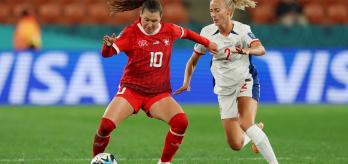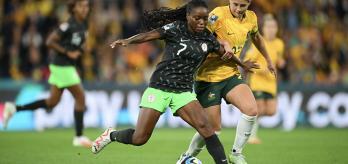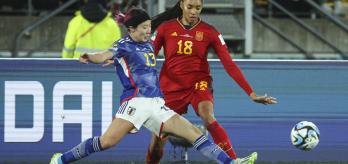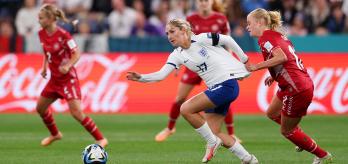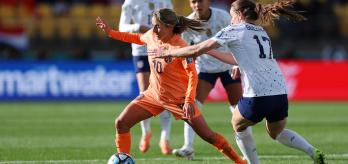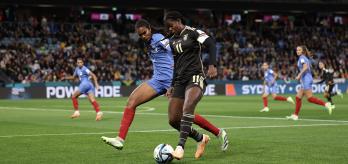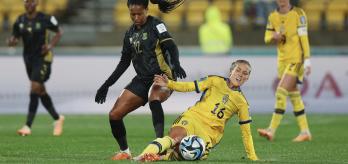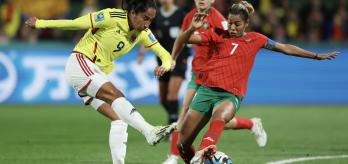England progress to the knockout stages as one of only three teams to have won all three of their group fixtures. Two wins were enough to see Denmark through in second place ahead of China PR. Although they finished with zero points, Haiti provided some of Group D's most memorable moments, including a valiant performance against England in their opening game.
England
Belinda Wilson: England's compact and narrow defensive shape shifts opponents towards wider areas, limiting access to central spaces in the mid-to-low-block. Their organised high-block press induces errors, enabling quick ball recoveries to exploit opposition weaknesses.
England's pivot player – usually Kira Walsh (4) – is crucial in possession, moving the ball from central to wide channels. Their full-backs, Lucy Bronze (2) and Rachel Daly (9), push forward during attacks, adding width and diverse passing options. The fluidity of England's wide forwards is notable, as Chloe Kelly (18) and Lauren James (7) rotate inside to receive the ball or execute penetrating runs to unsettle defensive lines.
Their attacking strategies display remarkable versatility, incorporating crosses, defence-splitting passes, and capitalising on 1v1 situations. James is a standout player, demonstrating exceptional quality and creativity around the penalty area and posing a significant threat to opponents. Overall, these tactical themes define England's team identity, and they exhibit a distinctive and successful playing style.
Denmark
Nadine Angerer: Denmark had a 4-3-3 or 4-2-3-1 formation in build-up. Their build-up was patient and they looked to play long, direct passes from centre-backs Stine Ballisager (3) and Simone Boye (5) into wide channels or directly into the forward line towards centre-forward Pernile Harder (10). When their full-backs – usually Rikke Sevecke (4) or Katrine Veje (11) – or their wide forwards Janni Thomsen (19) and Rikke Maria Madsen (17) received balls in the wide channels, they looked to cross into the box, or play balls behind the defensive line. The wide forwards on the opposite side of the pitch, Harder, and the attacking midfielders repeatedly made good runs into the box to ensure Denmark had numbers in the penalty area for crosses.
Out of possession, Denmark were in a 4-4-1-1 shape in a low block, a 4-4-2 formation in a mid-block, or in a 4-2-3-1 formation in a high block. Denmark's full-backs applied good direct pressure to avoid dangerous crosses into the box. The centre-backs and full-backs maintained a very compact structure and had good support from midfielders and forwards.
Denmark in general looked structured and compact. In Pernille Harder they have a constant threat up front who is able to score at any time, and they are also the tallest team in the tournament, making them tough to beat in physical duels.
China PR
Mónica Vergara: China's defensive shape was 4-4-2, with mid or low blocks and presses. They played as a tight unit to reduce the size of the pitch, close the space between their lines and force the opposition into the tighter spaces to apply pressure and recover the ball.
Once they regained possession of the ball, their transition to attack was as direct and quick as possible. Their forwards pushed up to pressure the opposition defensive line. At the FIFA Women's World Cup 2023™ we saw they were organised both with and without possession, and they managed to win one of their three games.
Haiti
Clémentine Touré: Haiti's tactics remained identical across their three group matches. From an attacking point of view, Haiti's game consisted of short passes and long balls (counter-attacks) to attackers Melchie Dumornay (6) and Roseline Eloissaint (11), with the active participation of wide midfielders Nérilia Mondésir (10) and Batcheba Louis (7) and full-backs Betina Petit-Frère (13) and Chelsea Surpris (2) in their offensive game.
They managed to create plenty of goalscoring opportunities, but failed to score, showing inefficiency in all of their three games. This could be explained by the lack of experience within this young team, which was competing in its first World Cup. The team were overly reliant on a small number of players, with most moves focused on Mondésir, Sherly Jeudy (9), Louis, and Eloissaint.
Haiti's offensive transition was a weakness they will need to work on. Their attacks were not well organised, and tended to be directed on the basis of the opposition's press. This was one reason why they frequently had to resort to long balls up to their striker – often Roselord Borgella (22).
Similarly, inexperience also told in defence, as Haiti left large spaces between opposition lines and in behind the back four. The defence was also slow to withdraw and struggled to deal with aerial balls. Finally, they did not defend as a unit in transition; often, two or three players would harass the player on the ball without their team-mates getting involved. These are all issues they will need to address in order to improve.








